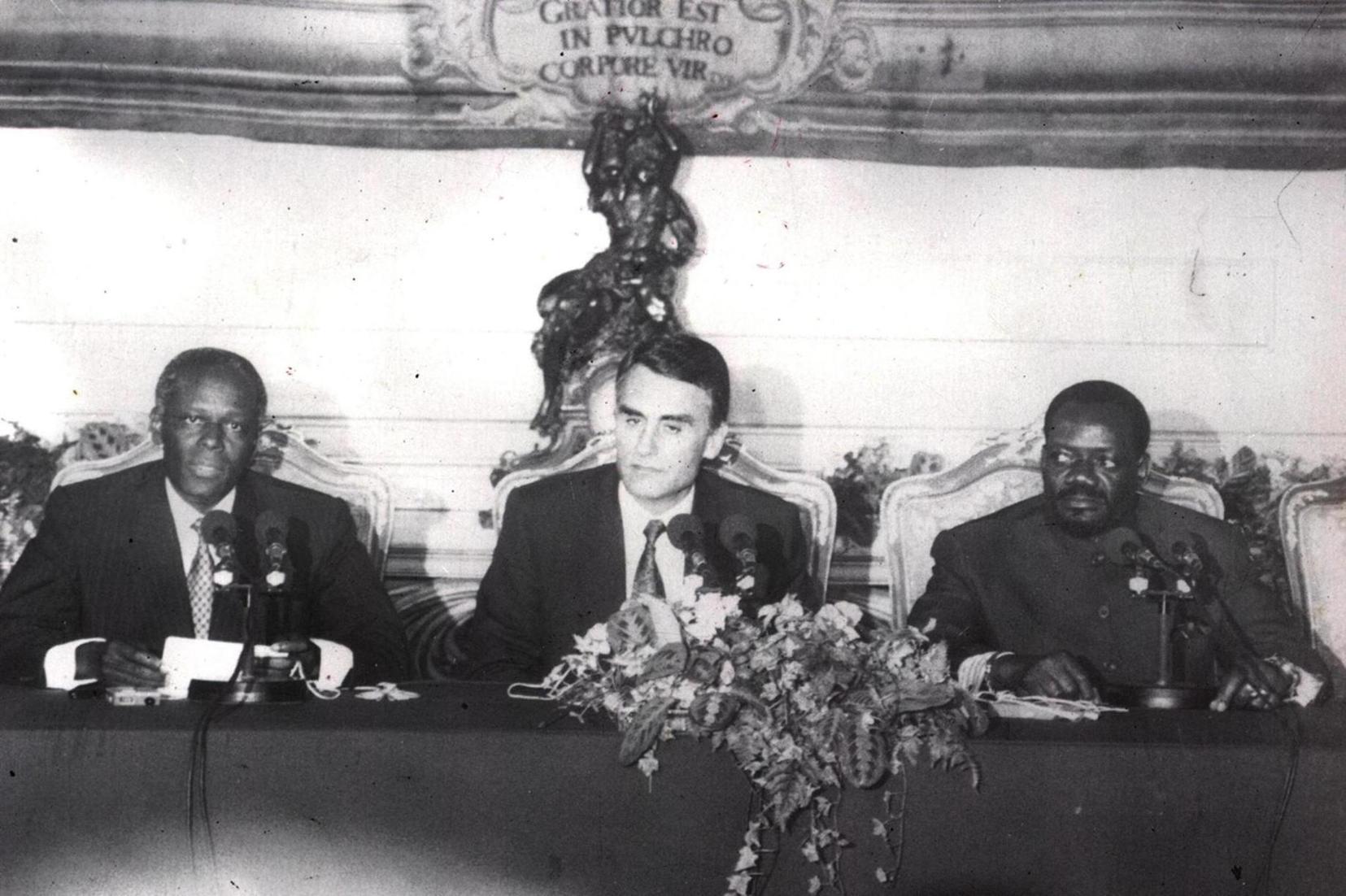Africa-Press – Angola. Angola marks Wednesday 32 years since the signing of the Bicesse agreements between the Government and UNITA.
The agreements, signed on May 31, 1991, boosted the implementation of the multi-party democratic system and laid the foundations for holding the first general elections in the country.
Signed in the city of Estoril (Portugal), the Bicesse Accords constituted an important milestone for the country’s political transition, although it was short-lived and did not prevent the escalation of war.
The signing of these agreements was preceded by several rounds of negotiations, between April 1990 and May 1991.
Essentially, the Bicesse Accords, initialed by the former President of the Republic, José Eduardo dos Santos, and by the then leader of UNITA, Jonas Savimbi, aimed at ending the war in Angola, implementing the multi-party system, boosting democracy and achieving of free and fair elections.
The text determined, among other important points, a ceasefire between the military forces of the Government and UNITA, monitored by the Joint Political-Military Commission (CCPM), constituted by representatives of the two parties in conflict, by the mediation (UN) and by the observers (USA, Portugal and Russia).
It established the period from 1 September to 1 October 1992 for holding presidential and legislative elections, at the end of which the powers of the CCPM would cease.
Still within the framework of the Agreements, the United States of America (USA) and the former Union of Soviet Socialist Republics (USSR – today the Russian Federation), committed themselves to cutting off the supply of weapons to the parties involved in the conflict.
It was, in practice, the second attempt, after the failed Agreements of Alvor (Portugal), in 1974, and of Gbadolite (former Zaire, current DRC), in 1989, for the Angolans to find lasting solutions for the end of the war that Angola lived since the proclamation of National Independence, on November 11, 1975.
Given the complexity of the process and in order to enhance the credibility of that important political, diplomatic and legal act, the signing of the Agreements was mediated by Portugal, in the person of Durão Barroso, former Secretary of State for Foreign Affairs and Cooperation. The role of observers fell to the USA and the former USSR.
As part of the signing of the Bicesse Accords, Angola and the Angolans saw the birth of their second Constitutional Law, which guaranteed the country’s transition to a market economy.
The document created the conditions for the establishment of the multi-party regime, as well as extending the fundamental rights and freedoms of citizens, including political rights.
With the signing of those legal instruments, it seemed that 16 years of military confrontation between the forces of the Government and UNITA had finally been left behind, opening a new page in the history of the country.
Angola and the world saw the emergence of an atmosphere of celebration and pacification between children of the same country, divided by political and ideological convictions resulting from the cold war, who had in these agreements the hope of seeing the silencing of weapons and advancing towards multi-partyism.
Holding of the first elections
The holding of the first multiparty and presidential elections, which should take place between 15 and 18 months from the date of signature of the agreements, under the coordination of the then National Electoral Council (CNE), was one of the key points of the entire process.
As part of the exercise of its functions, the newly created CNE started with the voter registration process throughout the country, supervised by UNAVEM II, also responsible for supervising, organizing the polls and counting the ballot papers.
The holding of the elections, on the 29th and 30th of September 1992, was marked by the large turnout of voters, in practically the whole country, having been considered free and fair by the United Nations, in the person of the special representative of the UN Secretary General , Margaret Anstee, observers in particular, and the international community in general.
With this step, the country was able to face the future with optimism and confidence, dreams that were quickly shattered after the suffrage took place.
Against all expectations, the celebration of democracy would give way to a new wave of armed confrontations. After the election results were known, Angola entered a new spiral of violence, which many analysts consider to have been the most destructive since the beginning of the conflict.
However, although the Bicesse Accords did not fully fulfill their role, they were one of the “shortcuts” that allowed Angolans to reach definitive peace in 2002.
Unlike the Alvor Agreements, which led to the proclamation of National Independence, and the ephemeral Gbadolite Agreement, those of Bicesse arise with the mission of filling the gaps and failures of the previous ones and marking, definitively, the seal of peace.
However, despite the euphoria of the Angolans, the fruits of the Bicesse Accords were short-lived, that is, only one year, following, in practice, the same logic as the Gbadolite Conference.
In Gbadolite (1989) a declaration was produced that provided for a ceasefire between the parties, witnessed by 17 Heads of States and Governments. With this step, the idea that the war in Angola had its days numbered became almost generalized.
It was with the desire and responsibility to do better that the political and military actors, under foreign mediation, set out to materialize the Bicesse Accords, preceded by technical meetings between delegations of the Angolan Government and UNITA, in February 1991.
These preliminary bilateral contacts involved the observers, but were not conclusive. The impasse was resolved with the adoption and signing of a document, under the supervision of observers, which served as a basis for the next round of negotiations.
Studies indicate that in April, in Bicesse, the last round of negotiations around the document took place, with the participation of José Eduardo dos Santos, Jonas Savimbi, Quett Masire (then President of Botswana), Pierre Buyoya (Burundi), Aristides Pereira (Cape Verde) and Hissene Habre (Tchad).
Also present were a representative of the then Organization of African Unity (OAU), Presidents João Bernardo Vieira (Guinea-Bissau), Denis Sassou-Nguesso (Congo), Omar Bongo (Gabon), Moussa Traoré (Mali) and Joaquim Chissano (Mozambique). ).
The list was completed by Ibrahim Bambagida (Nigeria), Manuel Pinto da Costa (São Tomé and Príncipe), Mobutu Sese-Seko (former Zaire), Kenneth Kaunda (Zambia), Robert Mugabe (Zimbabwe) and Ali Hassan Mwinyi (Tanzania).
Of the “strengths” of the negotiations, the understandings recorded in relation to the need for a cease-fire, consecration of multipartyism, formation of a single army, total withdrawal of all Cuban internationalist troops from Angola (until 1 July of the same year ) and the creation of conditions for holding the first presidential and legislative elections.
Within the framework of the agreement, the parties agreed to establish a new peacekeeping mission in Angola, UNAVEM II, responsible for supervising the actions to be carried out by the actors in the process. The agreements provided for the placement of FAPLA and FALA troops in the Angolan Armed Forces (FAA) and the demobilization of surplus forces on both sides, as well as the restoration of state administration in UNITA-controlled areas. It was a crucial step towards ending the war in Angola and opening the country to democratic foundations.
If, on the one hand, Angolans went to the polls, as stipulated in the Bicesse Accords, it should be noted, on the other hand, that, despite the initialed agreements, peace never became effective in the country, which led, once again, to the parties to the conflict at the negotiating table in 1993, first in Namibe, followed by Addis Ababa (Eitopia), Abidjan (Côte d’Ivoire), Lusaka (Zambia – Lusaka Protocol) Luena (Moxico – Complementary Memorandum of Understanding to Lusaka Protocol).
The Bicesse Accords have the merit of marking the beginning of a new political regime, the multi-party one, which is consolidated daily in Angola, and of the change in the economic system, marked by the market economy.
These two aspects may be, in addition to the holding of the 1992 elections, the points best achieved with the Bicesse Accords, a milestone that will remain in the minds of Angolans, above all, due to its importance in the strategy for resolving the armed conflict.
The armed conflict in Angola ended definitively in 2002, after the death in combat of the then UNITA leader, Jonas Savimbi, which opened the door to the initial phase of the country’s national reconstruction and development process.
With the establishment of peace, Angola has been rising from the ashes and taking steps towards reconstruction, with the rehabilitation of roads, railways and public institutions, in addition to creating favorable conditions for improving the environment of business.
For More News And Analysis About Angola Follow Africa-Press






